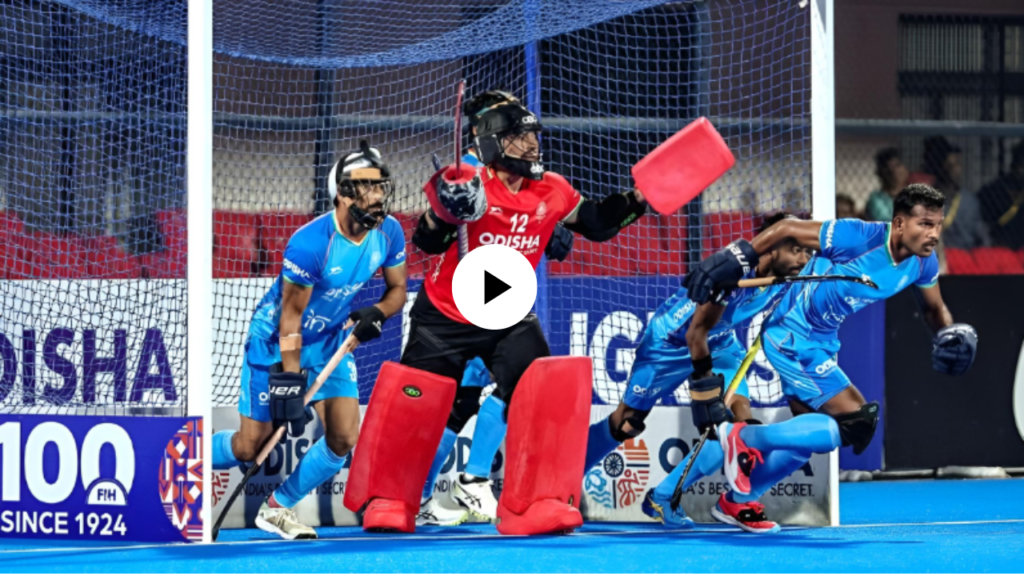It has not been the perfect start but neither has it been too bad. The Indian men’s hockey team ended the Bhubaneswar leg of the FIH Pro League with a hard-fought 1-0 win over Ireland on Friday.
In four matches so far, they have won two, won another via a shootout and lost one. While the first two matches against Spain and the Netherlands showed how India banked on their senior players to deliver, the games against Australia and Ireland produced evidence that more work is required to achieve tactical control on the pitch.

India vs Australia: A tactical masterclass, until it was not
It could’ve gone all wrong for India after Australia scored in the opening two minutes. But the Indians stuck in there to bounce back and score four goals. Eventually, though, the match slipped away as India conceded four more goals to lose the match 6-4.
EDITOR’S PICKS
- Last minute Gurjant goal gives India 1-0 win against Ireland16hAnirudh Menon
- Ireland, India and the Fulton link between their hockey teams1dAnish Anand in Bhubaneswar
- FIH Pro League: Australia pull off stunning comeback to beat India 6-42dAaditya Narayan
Despite being 0-2 down against the mighty Aussies, India didn’t panic: a commendable sign considering the many hapless defeats they’ve faced against the same team. They played to their game plan and found success via a series of aerial balls, which Australia did not expect and could not deal with.
However, after the half-time break, India lost control and allowed Australia to play their natural aggressive brand of hockey. Once you let the Aussies create chances, they will make you pay. Speaking post the game, Fulton felt India had lost their defensive structure in the second half and that proved costly.
What Fulton said was visible on the pitch as India’s defensive lapses saw them concede four goals and it also allowed Australia to realize what they were doing wrong and rectify. They improved their zonal defending, dealt with the aerial balls better and as always, used the width of the pitch for quick transitions. It also helped that they have world-class finishers in Blake Govers, Jeremy Hayward and Lachlan Sharp. While Australia made those changes, India didn’t quite adapt to them. Maybe India could’ve survived in a similar situation against the Asian teams, but that isn’t the case against the world’s top hockey nations like Australia, Netherlands and Belgium.

India started that second half slowly and were docile on the pitch. Perhaps the idea was to frustrate the Aussies by slowing the pace of the game and then using those aerial balls to find success. Unfortunately for them, the Aussies read the plan. A couple of goals and India crumbled. They couldn’t win a single penalty corner in the second half, while Harmanpreet Singh had scored two in the previous half. It was a wild game that ended with a lesson in tactical awareness from a champion side like Australia.
India vs Ireland: The struggle continued
India eventually got back to winning ways thanks to Gurjant Singh’s smashing finish against the Irish, but it came after a struggle that lasted for 59 minutes. India were up against a resolute Irish defence. They man-marked the Indian attackers, created a low block inside the D and got the majority of their tackles spot on. It took a special finish to break Ireland’s defence, that too with a minute remaining on the clock.
Fulton said that the previous night’s match against Australia took a lot out of the team, and it could be the reason for an ordinary performance against Ireland. India did enough to win the game, but the in-game tactical awareness part also applies here. Unlike the Aussies, the Irish had just one plan and stuck to that. It appeared that India were waiting for them to commit mistakes instead of forcing changes to their approach.

Fulton’s men seemed keen to make an impact through their counter-attacking and hence allowed the Irish players to keep possession. The plan, thouIt just didn’t work, Ireland barely committed any mistakes and India’s counter-attacking strategy didn’t materialise to full effect. India should’ve been a bit more active on the ball and tried different methods to break the defence.
In a larger context, in Olympic terms, Australia and Ireland are two important teams for India as all three have been placed in the same pool alongside Belgium, Argentina and New Zealand. For all three teams, these Pro League matches hold crucial learnings and they will hope to learn more when they meet in Rourkela.
FIH Pro League Rourkela leg schedule:
February 19: Ireland vs Netherlands at 5.30 pm; India vs Spain at 7.30 pm.
February 21: Spain vs Australia at 5.30 pm; India vs Netherlands at 7.30 pm.
February 22: Ireland vs Australia at 5.30 pm; Netherlands vs Spain at 7.30 pm.
February 24: Spain vs Ireland at 5.30 pm; India vs Australia at 7.30 pm.
February 25: Australia vs Netherlands at 5.30 pm; India vs Ireland at 7.30 pm.

Leave a comment